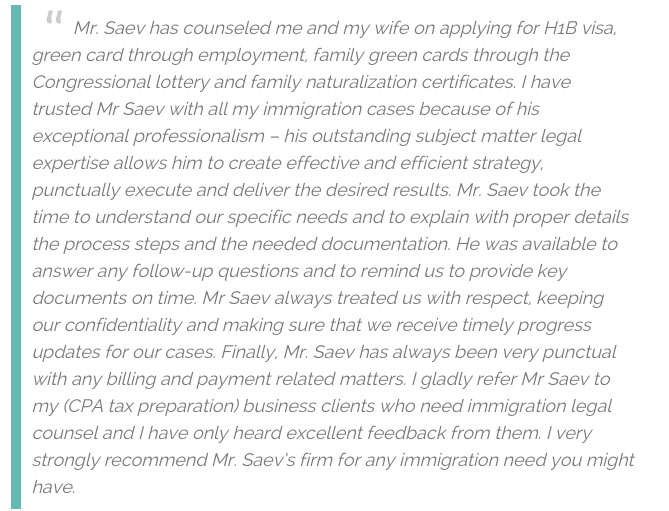The H-1B visa is one of the most frequently seen temporary work visas in the U.S. immigration field. This classification typically applies to foreign professional workers who are employed in specialty occupations. It also applies to foreign workers who provide services of exceptional merit and ability relating to a Department of Defense (DOD) cooperative research and development project, as well as services as a fashion model of distinguished merit or ability. H-1B family members qualify for H-4 classification. H-4 family members are typically not authorized to work in the U.S.; however, H-4 spouses of certain H-1B workers who have pending employment based permanent residence cases are work-authorization eligible.
A. H-1B Specialty Occupation
Specialty occupation means a position that:
-
1) typically requires a bachelor’s or higher degree as the minimum entry requirement
2) the degree requirement for the job is common to the industry or the job is so complex or unique that it can be performed only by an individual with a degree
3) the employer usually requires a degree or its equivalent for the position
4) the job is so specialized or complex that the knowledge required to perform the job is usually associated with the attainment of a bachelor’s or higher degree.
To qualify for H-1B classification, the foreign worker must hold a bachelor’s or higher degree (or a foreign equivalent degree) or possess a certain level of education, training, and/or progressively responsible experience in his or her specialty that is equivalent to the completion of such a degree. Businesses wishing to employ H-1B workers must additionally obtain an approved Labor Condition Application from the U.S. Department of Labor and commit to meet certain wage, working condition, posting, and public disclosure requirements. In certain situations, employers may also be required to offer to pay the return transportation for H-1B worker to his or her home country.
➔ H-1B workers are usually admitted for a period of up to three years and their status may be extended for up to six years. In certain situations, the H-1B worker’s status may be extended beyond six years if there is a permanent residence case on file. Certain H-1B position are subject to an annual numerical “cap” of 65,000. There is an additional 20,000 H-1B numbers specifically reserved for foreign national who have a U.S. master’s degree or higher. However, not all H-1B workers are subject to this numerical limitation. For example, H-1B employees who are currently in H-1B status and who are switching employers but remain in H-1B status are exempt from the cap. Also, H-1B workers who will be employed at an institution of higher education, or an affiliated nonprofit research organization, or a government research organization, are not subject to this numerical cap.
B. H-1B2 U.S. Department of Defense Research and Development Worker
This classification is for workers who are engage in cooperative research and development project or a co-production project under a government-to-government agreement administered by the U.S. Department of Defense. The position must also require a bachelor’s or higher degree or its equivalent to perform the job duties. The U.S. employer is not required to submit a Labor Condition Application with the U.S. Department of Labor for this visa type.
C. H-1B3 Fashion Model
Unlike the typical H-1B worker, H-1B3 fashion modes are not required to possess a bachelor’s degree or its equivalent. However, the worker must be a fashion model of distinguished merit and ability and the job position must require a fashion model of prominence. The U.S. employer must obtain an approved Labor Condition Application to petition for fashion models.
What a Former Client has to say about our help with their H-1B Visa

To see the full review, and others like it, visit Milen Saev’s Avvo page.